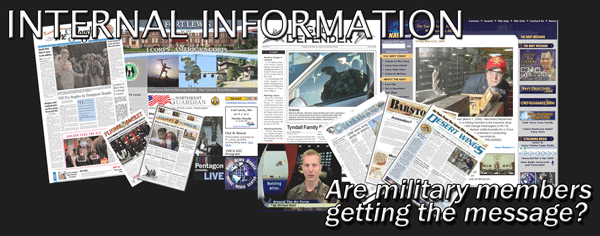Burgoon, M., Cohen, M., Miller, M.D., & Montgomery, C.L. (1978). An empirical test of a model of resistance to persuasion. Human Communication Research, 5, 27-39
Dimmick, J., Chen, Y., & Li, Z. (2004). Competition between the Internet and traditional news media: The gratification-opportunities niche dimension. Journal of Media Economics, 17 (1), 19-33.
Everett, S. (2005). Navy communication survey results 2005. The Everett Group
Fallows, D. (2004). The Internet and daily life [Paper posted on the Web site Pew Internet & American Life Project]. Retrieved February 9, 2006 from the world wide web: http://www.pewinternet.org/PPF/r/131/report_display.asp
Fox, S. (2005). Generations online. [Paper posted on the Web site Pew Internet & American Life Project]. Retrieved February 9, 2006 from the world wide web: http://www.pewinternet.org/PPF/r/170/report_display.asp
Katz, E. (1959). Mass communication research and the study of culture. Studies in Public Communication, 2, 1-6
Katz, E., Blumler, J., & Gurevitch, M. (1974). The uses of mass communication. Beverly Hills, CA: Sage Publications, Inc.
Katz, E., Blumler, J., & Gurevitch, M., (1973). Uses and gratifications research. Public Opinion Quarterly, 37(4), 508-523
Kaye, B., & Johnson, T. (2002). Online and in the know: Uses and gratifications of the web for political information. Journal of Broadcasting and Electronic Media, 46(1), 54-71
Ko, H., Chang-Hoan, C., & Roberts, M. (2005). Internet uses and gratifications. Journal of Advertising, 34(2), 57-70
Massey, K. (1995). Analyzing the uses and gratifications concept of audience activity with a qualitative approach: Media encounters during the 1989 Loma Prieta earthquake disaster. Journal of Broadcasting & Electronic Media, 39(3), 328-340
Madden, M. (2003). America's online pursuits: The changing picture of who's online and what they do. [Paper posted on the Web site Pew Internet & American Life Project]. Retrieved February 9, 2006 from the world wide web: http://www.pewinternet.org/PPF/r/106/report_display.asp
Newell, C., Whittam, K., & Uriell, Z. (2005). CHINFO media quick poll. Navy personnel research, studies, & technology
McQuail, D. (1984). With the benefit of hindsight: Reflections on uses and gratifications research. Critical Studies in Mass Communication, 1, 177-193
Mensing, D. (1997). Prospects for profit. [Data posted on the Web site International Newspaper Marketing Association]. Retrieved February 18, 2006 from the world wide web: http://www.inma.org/subscribers/papers/1997-mensing.pdf#search='online%20newspaper%20publishing%20costs'
Newspaper Association of America. (2006). Readership statistics. [Data posted on the Web site Newspaper Audience Database, Newspaper Association of America]. Retrieved February 9, 2006 from the world wide web: http://www.naa.org/artpage.cfm?AID=1468&SID=1113
O’Keefe, G., & Spetnagel, H. (1973). Patterns of college undergraduates use of selected news media. Journalism Quarterly, 50, 543-548
Palmgreen, P., Wenner, L.A., & Rayborn, J.D., II (1980) Relations between gratifications sought and obtained: A study of television news. Communication Research, 7, 161-192
Perse, E., & Rubin, R. (1989). Attribution in social and parasocial relationships. Communication Research, 16(1), 59-78
Schramm, W., Lyle, J., & Parker, E.B. (1961). Television in the lives of our children. Stanford, CA: Stanford University Press.
Singer, J.B. (2001). The metro wide web: Changes in newspapers’ gatekeeping role online. Journalism and Mass Communication Quarterly, 78, 65-80
Stafford, T., & Stafford, M. (2001). Identifying motivations for the use of commercial web sites. Information Resources Management Journal, 12(1), 22-30
Stafford, T., Stafford, M., & Schkade, L. (2004). Determining uses and gratifications for the Internet. Decision Sciences, 35(2), 259-288
Rainie, L., & Horrigan, J. (2005). A decade of adoption: How the internet has woven itself into American life. [Paper posted on the Web site Pew Internet & American Life Project]. Retrieved February 9, 2006 from the world wide web: http://www.pewinternet.org/PPF/r/148/report_display.asp
Rayburn, J.D. (1996). Uses and gratifications. In B. Salwen, D. Stacks (Eds.), An Integrated Approach to Communication Theory and Research, (pp. 145-163). Mahwah, NJ: Lawrence Erlbaum Associates
Rayburn, J.D., Palmgreen, P., & Acker, T. (1984). Media gratifications and choosing a morning news program. Journalism Quarterly, 61, 149-156
Ruggiero, T. (2000) Uses and gratifications theory in the 21stcentury. Mass Communication & Society, 3(1), 3-37
Vincent, R., & Basil, D. (1997). College students’ news gratifications, media use, and current events knowledge. Journal of Broadcasting & Electronic Media, 41(3), 380-393
United Nations. (2005). United Nations human development report 2005. New York, NY
U.S. Air Force. (2005). Eglin Air Force Base newspaper survey 2005. Shalimar, FL
U.S. Air Force. (2005). Elmendorf Air Force Base newspaper survey 2005. Anchorage, AK
BACK TO TOP
